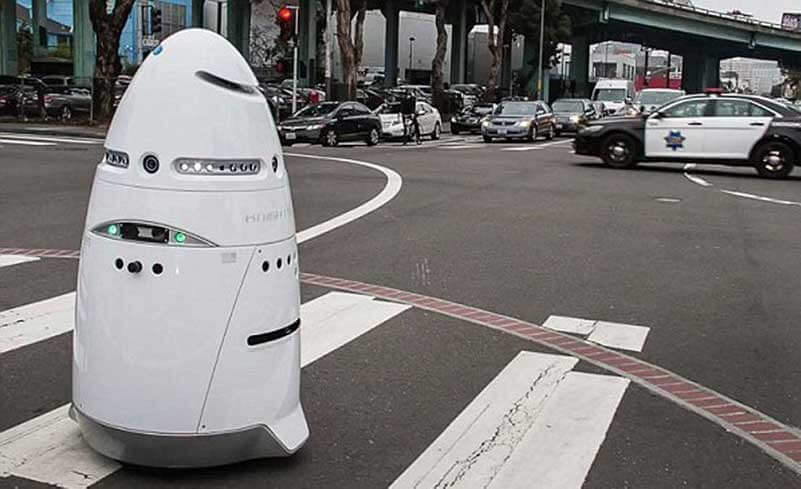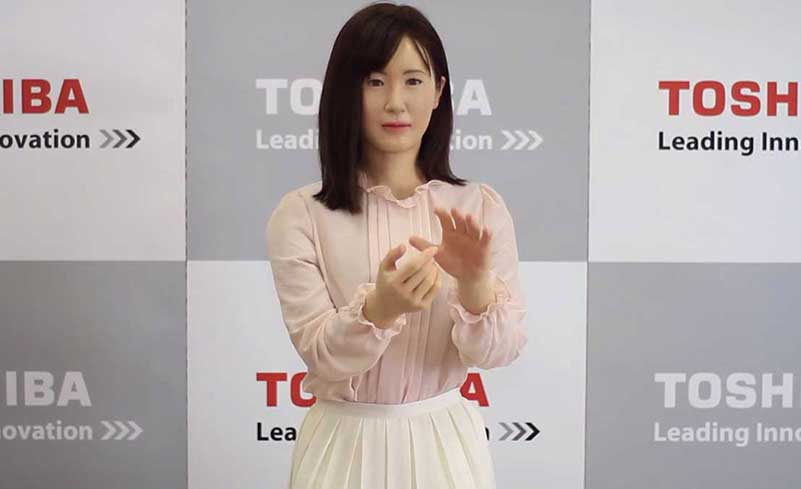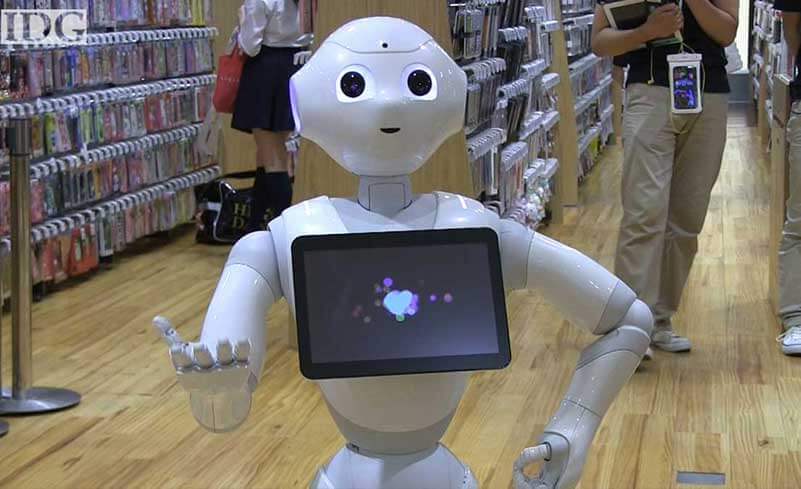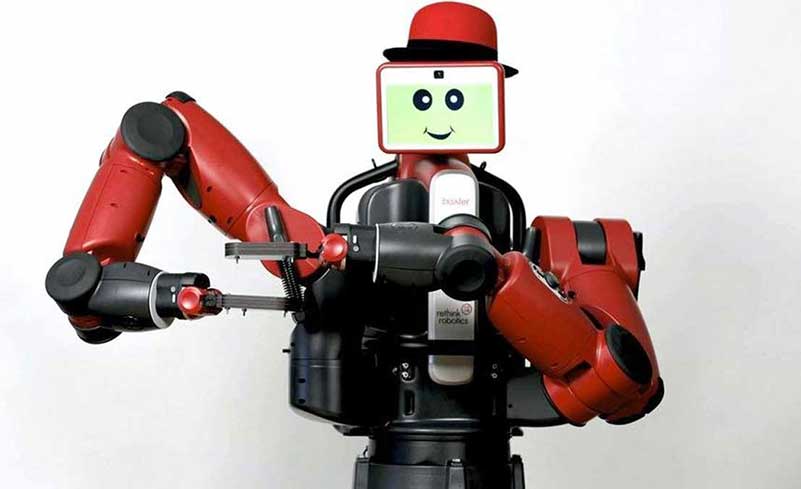- Robocop may soon be a reality: Dubai aims at first launch in 2017
- Robots at Japanese departmental store
- Global security as automated reality? One soldier in command of entire troops!
- Super-strength is a robotic reality now
- Humanoids with more human-like behavior than ever: Facial expressions and more
- Believe you have a safe and secure job? Time to rethink!
- What do we take from our speculations on futuristic robots and their related technology?
Twenty years ago, if I had told you that robocop might become a real thing in the future, you would have laughed right into my face. Nevertheless, as we have seen in the previous posts, robotics has indeed taken a huge leap since George Devol (pioneer of industrial robotics) filed a patent for the first programmable robot and coined the term “universal automation.” In this post, we explore some futuristic robots that are poised to change many aspects of human life.
From completely intelligent police robots to beautiful shopping assistants and cybernetic supermen, every element of our favorite science fiction novels is experiencing reality. Not all is rosy, of course. The threat from such futuristic robots in terms of automation and artificial intelligence is very real and can be compared easily to what the Terminator told us. The peril of increased automation and consequent unemployment is looming over us, and so is the threat of machines taking over (although there is a lot of debate on that)! Robotics may sound like a relatively newer science to many; however, the concept is quite old and goes back to around 1400 BC! The Babylonians developed the clepsydra, a clock that measures time using the flow of water. This legendary device is considered one of the first robotic devices in history. It was reimagined over centuries, and around 270 BC, Greek inventor Ctesibius earned fame for a water clock with moving figures on it.
Thus, we can say that the curiosity of making machines that reduce human effort to a minimum has always been a primal focus of men in the field of science (this includes even science fiction writers such as HG Wells and Isaac Asimov). In this post, we explore the trending research involving futuristic robots and speculate the good and bad consequences they will bring.
Robocop may soon be a reality: Dubai aims at first launch in 2017
I have always been fascinated by the idea of futuristic robots who will uphold the law and protect the society. However, this kind of artificial intelligence also leaves room for some scary speculations! The Dubai police force recently announced intentions to launch robotic police patrol droids by 2017. These futuristic robots will be fully intelligent, according to Colonel Khalid Nasser Alrazooqi, who leads the city’s smart unit. However, if you are imagining the neighborhood-friendly Robocop to save the day, you are in for a little disappointment. The first prototypes will only be deployed in areas with low crime and bustling with tourists, and the duties will be limited to providing information and directions, and contacting human police officers when required. These futuristic robots will interact with people and tourists through their interactive screens and microphones connected to the Dubai Police’s call centers. People can ask questions, lodge complaints, and have fun interacting with these bots. Of course, there is scope for more advanced prototypes in the time to come.

The city hopes to have fully AI-driven models on the streets within four to five years. This advancement will aim at nullifying human interference for good. Research on such endeavors is underway. The current prototype is more cute than intimidating. Until recent times, robotics research was limited to providing efficient parking or traffic solutions; however, now the agenda is changing. Knightscope, a Silicon Valley-based robotic startup, has claimed to have been developing the next generation of security droids. The company has not disclosed much but who knows what it will come up with! Will we indeed see Robocops and Terminators in the near future? How will the developers achieve a perfect balance between logic and humane aspects when it comes to handling criminals? Such controversial speculations are bound to rise when one thinks about how artificially intelligent these futuristic robots may be. Groups with the United Nations are already taking steps to stop and illegalize these automation advancements. They have even coined the term “autonomous killing machines” in a bid to make people aware of the possible dangers. On the other hand, there are groups which believe that this kind of technology would help in better implementation of the law, as a logical approach is best when handling crime and criminals.
So the question is: Can we have machines which show the same level of morality, sympathy, lateral thinking and empathy as human cops do? Will aiming at an error-free artificial enforcer eliminate the possibility of the important abstract elements a cop must have? I guess we may all be terrified and excited at the same time thinking about the possibilities. The final answer is locked in the time to come.
Robots at Japanese departmental store
How many times have you been stranded or lost in a departmental store? With so many products and choices to look around, one is bound to be in need of some assistance. What better than a range of futuristic robots designed to entertain you while you get to know everything about what you want, and then get pointed in the right direction? Here comes Aiko, a humanoid robot! Aiko Chihira requests you to listen to her song while she finds your products. Dressed in a kimono, Aiko greets shoppers at the entrance of Tokyo’s Mitsukoshi department store with a vibrant smile.
Toshiba developed the robot last year and it debuted at the store last Monday. Its prime role is to interact with customers. Aiko can speak Japanese, Chinese, and other languages which can be easily programmed on to her interface. What’s more, she blinks as well! At her unveiling on Monday, she requested esteemed Japanese opera singer Shoko Iwashita to listen to her composition. She lip-synced the opera queen and later requested the audience for a round of applause. Impressive, isn’t it?

Aiko is not programmed to respond to customer complaints or questions but she can be a good guide to customers. The robot has 43 motors which allow it to move. It is also programmed to answer in Japanese sign language. This is one development in the area of futuristic robots which has lesser scope of heavy critique by sceptics as the locus of control given to these humanoids is far lower than other AI prototypes. By the way, Aiko is not the only humanoid used in retail! Pepper is another humanoid which helps sell Nestlé’s Dolce Gusto and Gold Blend Barista coffee machines in home appliance stores in Japan. She is the first among our futuristic robots to read and respond to human emotion. She is also equipped with the latest voice and emotion recognition technology. This enables her to read people’s facial expressions and listen to their tone of voice. She can then analyze what they are feeling and proceed accordingly.

Aiko and Pepper are examples of what the future of retail will be like. Recently, we also saw Amazon launching drones for delivery. All this points toward effortless buying and individual marketing in the future. I surely like it. What do you think?
Global security as automated reality? One soldier in command of entire troops!
Another major speculation that revolves around futuristic robots is the extent of automation in the near future. The 20th century can be easily called as the age of automation. Throughout the century, we have seen increased number of processes where human involvement reached complete termination and machines took over. Although the master controls have been in human hands, going forward, things will be more automated and increased control will be given to robots through artificial intelligence.
Development regarding the next generation of military robots is in full flow at the naval research facility along the stretch of the Pacific Coast of San Diego. Civil engineers are consistently developing active-duty troops laced with AI and advanced robotics. Such research gives people like me an idea about how these futuristic robots are poised to change the way we do business and live every day! The engineers, who are members of the Unmanned Systems Group at the Space and Naval Warfare Systems Command, the research operations arm of the Navy, have only one bottom line: Take out the enemy! They believe that these advanced robots will revolutionize military fights forever. Their vision is a fleet of driver-less trucks, or robot soldiers with one human supervisor who has all the controls. This will help counter the threat of chemical or biological warfare. Unmanned robots have been used by the military for over a decade now in the form of bomb defusing devices (for example, Packbot from iRobot), armed drones, MK-18 (which uses SONAR to detect mines in ocean beds), and a lot more.
Thus, it can be said that the application of such technologies in our day-to-day lives is inevitable. Advancement in war technology has had a direct effect on global operations. Inventions such as the dynamo-powered torch became a household item after its first use in the Second World War. What needs to be kept tab on is the extent of control given to these futuristic robots. The technology is not without the threat of being hacked and tweaked by hostile forces. So I guess the catch here must be to lay maximum stress on securing these machines! Regarding the extent of automation, we will talk about it later in this post.
Super-strength is a robotic reality now
Let me introduce to you MicroTug! MicroTug can pull objects nearly 2000 times of its size. To put its own size into perspective, imagine a human pulling a blue whale! Well, holy smokes, we have a super-robot here! This is one of the most likeable futuristic robots around as it does not trigger any global issues and threats! If you think the applications are limited, think again. How easy would construction become with no cranes to obstruct ongoing traffic and the life of construction workers becoming more safe and secure. And that is just one aspect. The MicroTug can also move an object 100 times its weight vertically up a glass surface. When compared to humans, it is the same as a human climbing a skyscraper while carrying an elephant!
The research guys at Stanford University’s Biometrics and Dextrous Manipulation Lab went deep when designing the MicroTug. They studied the uniquely gripping feet of ants and geckos which help them climb surfaces. The MicroTug is based on these creatures’ remarkable skills. It uses strong directional adhesives to tightly grip a surface. It is also laced with a large winch, tow cable, and hook. It employs on-board motors to pull the objects. 3D printers were used to make these parts.
I see a lot of scope in the MicroTug and other miniature futuristic robots. They are a launch pad for smaller (but with bigger applications) things to come with great possibilities. These robots can be employed in rescue missions, and help save thousands of lives in natural and artificial calamities such as earthquakes and tsunamis. They can work together as a team and solve complex situations, just like a team of soldiers who need to be rescued from a manhole or other hard-to-reach spots. Moreover, this is one branch of futuristic robots where speculation and skepticism can be avoided as these miniatures will always be remotely controlled and thus provide minimum threat. What do you think?
Humanoids with more human-like behavior than ever: Facial expressions and more
Remember T-1000 from Terminator II? It was an advanced robot that could calculate facial expressions and human behavior and respond to them. He could transform into whatever and whoever he wished. Thank the heavens for not letting the latter possible today; however, a humanoid that can tap into human behavior and respond accordingly has already been developed and is enthralling the people of Hong Kong. Ham, as everybody is calling him, can react to facial expressions and engage in conversations with full eye-contact and gestures. I believe it is both enticing and scary! The robot, designed by US-based Hanson Robotics, employs soft-bodied mechanical engineering and nanotechnology. I have had a look at its pictures and videos, and I can say that Ham is menacingly life-like. American robotics designer David Hanson, who has had special inputs with the head design, lauds his creation full on! Created with a malleable material called Frubber, the head has realistic pores that measure just 4 to 40 nanometres across! That’s microscopically exciting!
Ham is currently on display at the Global Sources Spring Electronics Show at AsiaWorld Expo and has stirred a lot of excitement, just like the other 4000 booths displaying the latest tech. However, Ham is not the first of its kind. Hanson Robotics was in news earlier for creating a humanoid called Albert Einstein, which made facial expressions using multiple motors. The question that is primarily bothering sceptics is: What is the scope of such research in futuristic robots that are artificially intelligent? Today they recognize facial expressions; tomorrow they can read your minds! Who knows! There are already talks about replacing waiters, receptionists, and call centers with fully intelligent robots. Does this mean unemployment for the lesser skilled? We will ponder more about that in the next and final part.
Believe you have a safe and secure job? Time to rethink!
Finally, we have come to the biggest scare we face from these futuristic robots: maximum automation and global unemployment scare. Experts predict that 30% of our current jobs will be performed by robots by 2025. Even the white collar jobs aren’t completely immune! Examples can be found everywhere. The BakeBot, which whips up fresh cookies for MIT grads, medical robots that assist expert doctors, Baxter, which beats the smartest humans at Connect Four, and many other tasks are mere small examples. The former two alone have reduced manpower considerably. Think what can accountant robots, receptionist humanoids, and more such futuristic robots could do the employment equilibrium. Scary, isn’t it?

Ryan Calo, who is a professor at the University Of Washington School of Law, says that the range of things robots can do has extended from the previous 3 Ds: dangerous, dirty and dull! According to Ray Kurzweil (director of engineering at Google), by 2029, robots are likely to reach human levels of intelligence. This has led many people to imagine a jobless future! With this level of intelligence, they can readily be financial and sports reporters, online marketers, surgeons, analysts, and what not. However, there are also some who see scope for newer and more refined jobs as technology advancements will result in newer products and services. They speculate something like the “Industrial Revolution” and are calling this revolution the “Second Machine Age.” The machines back then helped overcome the limitations of the human body. A Nesta/Oxford report has shortlisted occupations which are creative enough to avoid automation in the near future. Such jobs included artists, architects, web designers, and even IT specialists. The lowest probability of computerization was seen in jobs such as translation, performing arts, media production, and R&D. On the other hand, jobs such as peat extraction, projectionists, copper production, and bartending face very high probabilities of computerization.
The robots of tomorrow will overcome the limitations of the human mind! However, there are certainly no guarantees. We will need ourselves for jobs that require judgment, creativity, and human interaction. Experts agree that language manipulation such as jokes and sarcasm is beyond robotic capability, but who knows what lies ahead! Maybe a Tony Stark creates an Ultron and we never know what hit us!
What do we take from our speculations on futuristic robots and their related technology?
We had a look at robot cops who might patrol the cities of Dubai soon. Then there are these beautiful store assistants and interactive humanoids which can be sculpted into any form and talk to us, and even understand us (partly!). From advanced military tech to ball-sized robots lifting humongous weights, everything seems well, except when we start to speculate on the scope of things. We saw how these robots can leave us out of jobs, and then there is always the threat of AI going beyond our control. What we must realize is that the choice of expanding the scope is in our hands. Corporations and innovators must always think about the implications before officially launching such technology, and we the consumers must take full information and decide rationally whether to accept these huge advancements or not. The future is unexplored but we have the power of deciding how we want to move on.
Robotics and artificial intelligence are technologies only limited in advancement by human imagination. In the end, it all comes down to what John Connor told us: The whole thing goes: The future’s not set. There’s no fate but what we make for ourselves.
Share via:


